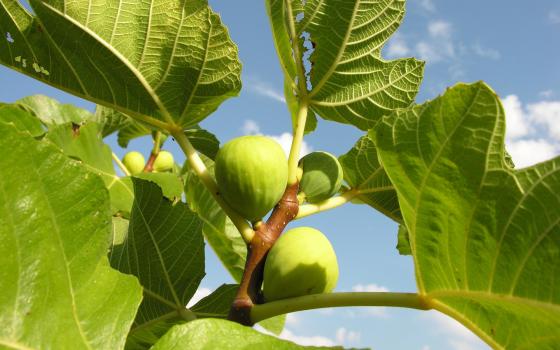Traditional spirituality explains grace from the Greek charis, meaning that which brings delight, joy, hope and happiness from the movement of the Spirit in the soul. A new insight appears and suddenly, what felt heavy and dark in body and soul, suffuses with light and joy. As much as I might desire an experience of grace, grace remains unmanageable and unpredictable.
These days, I am feeling short on grace, or out of touch with it, as despair seems to be seeping from the corners everywhere: church, country, and Earth … for starters.
My twin identities as an American and as a Catholic were formed in the idealism of the 1960s, and energized by the reforms of Vatican II and the leadership of Saint Pope John XXIII. These identities were grounded in values of openness to the modern world and a concerted effort to live the Gospel, with communities in the "trenches" of dynamic work for ecumenism, justice and peace. The relationships I formed in these communities while pursuing these Gospel values were grace filled and fueled my ministry experiences with abundant hope.
For example, as a Vatican II religious, it was quite clear to me that the ground of my hope would consist of watching with excitement how religious life and the church would evolve and flourish: the Vatican II reforms would be implemented and spawn new models and new life, both in religious life and the institutional church.
However, I have noticed through my own aging process, coupled with the changes in church and country, that these Vatican II reforms and the values upon which they were established, have not prevailed and are becoming blurred and slowly disappearing.
In addition, personal, familial and congregational losses compound my values disorientation. As institutions in the United States and the church grow increasingly lessresponsive to the people they serve, I find myself floundering and, in Ignatian terms, in "desolation of spirit."
Over fifty years ago, Thomas Merton warned in his last talk on December 10, 1968, in Bangkok, "I would suggest you remember this for the future: 'From now on, everybody stands on his own feet.' "
I can no longer count on the structures that are crumbling all around us; I must seek deeper wells of contemplative meaning, independent of external realities and institutions, that provide quiet hopefulness from within. In the words of the famous prayer by Fr. Ken Untener, inspired by St. Oscar Romero, we are urged to invest and "be prophets of a future not our own" while we continue, in the spirit and voice of Teilhard, to "trust the slow work of God."
In the midst of the dissolution of values that had formerly held springs of hope for me, I am striving to be attentive to sources of consolation that revive my disappointed inner spirit. I am seeking to be more attentive to grace in the everyday, and to let go of my American propensity for immediate and successful results that follow my personal timetable.
I recently accompanied an out of town visitor to our oasis of beauty and meditative quiet, the Cleveland Botanical Gardens. Although I enjoy visiting the gardens, I was not consciously looking for "spiritual graces" in them.
Among the many natural wonders in the Cleveland Botanical Gardens are two central exhibits: the desert of Madagascar and the rainforest of Costa Rica. Each time I visit, I am mysteriously drawn to the Strangler Fig tree in the Madagascar exhibit. My acquaintance with figs has been limited to stuffing them with nuts once a year around a Christmas Eve table with my Italian-American family; or reading the selection from Mark 11: 12-14 when Jesus curses a barren fig tree.
In Gods, Wasps and Stranglers: The Secret History and Redemptive Future of Fig Trees, rain forest ecologist Mike Shanahan describes the wondrous contributions made by the lowly fig tree to the life of our planet. This tree has been around for 80 million years; it can stretch over acres and produce over a million figs in one season!
Fig trees are known as a "keystone species" essential to the entire ecosystem. These marvelous trees grow in unlikely places, serve as a host home for a variety of other plants, shelter animals within their wide root systems and produce fruit that several species depend upon — including humans! Knowing these contributions of the fig tree, I think that perhaps Jesus' impatience with the sterility of the fig tree he encountered was because of an ecological concern!
Also found in the Madagascar exhibit is a 75 year old Baobab tree, a threatened species with a thick trunk and stubby branches. This one is host to a Strangler Fig, whose seeds germinated in the canopy and grew its roots down into the ground. The roots fused, forming a lattice work encircling the entire Baobab tree. The Strangler Fig then sprouted leaves and robbed the Baobab tree of sunlight, and the Baobab is dying from strangulation of its roots and lack of sunlight.
Without any "operating instructions" the Strangler Fig now has "captured" the hollow trunk of the Baobab, through whose opening I walk every time I visit. Yes, walk throughand stand inits trunk. The Baobab trunk then provides a home to thousands of rodents, bats, reptiles and birds—a witness for me to the Mothering God's continuing care of all creatures.
Shanahan credits these fig trees as one of the most important plant systems in the rainforest ecosystem, providing food and shelter to hundreds of species, including humans!!
Upon reflection I ask myself: Am I walking in a tomb of a dead tree or the arch of a live tree? Well, the answer is both. The Strangler Fig and the Baobab are paradoxically evolving together: living and dying.
Together, these two trees are a living witness to me of my need for a deeper awakening to the cycles of life and my awe at a very inscrutable process: the co-dependent evolution of life and death which is in me, my church, my country and my world.
I, along with thousands of religious women and laity, who strove mightily to live the spiritual values of Vatican II, hope to be part of a "keystone species" that spawns individuals who participate in this graced mystery of values, which, like seeds, regenerate across centuries.
These two intertwined trees enkindle my hope in the grace that partnership in the cycle of life and death produces ever more life. In the spirit of Dr. King, I am graced with peace and contentment in carving my own "stone of hope" out of my personal "mountain of despair" and appreciating that the timetable for this regenerative process belongs to the Source of all graces, meanings and values.
[Beverly Anne LoGrasso, a member of the Cleveland Ursuline Sisters since 1965, has served in education, administration and prison ministry to women. An article on her experience in prison ministry was published in the National Catholic Reporter.]

